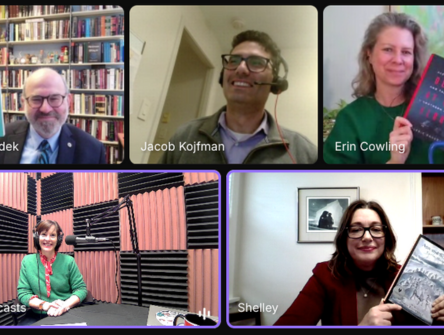Avoiding death by PowerPoint
So you’ve been asked to participate in a conference. You’ll be part of a panel discussion alongside other colleagues, or share your expertise on a particular topic. It’s a great opportunity to connect with other lawyers and build your reputation within the legal profession – if your presentation is done well.</p>

But how sharp are your presentation skills? If you don’t have the chance to present in front of large groups on a regular basis, you might have trouble holding people’s attention. Most of us know how to prepare speaking notes and PowerPoint slides, but communicating effectively on stage is another matter.
This can make us feel less confident and lead to nervousness, notes Mila Naimark, president of Clockwork Talk, a Toronto-based company that focuses on helping professionals become more influential presenters. She has the following tips to help presenters communicate their message more effectively while retaining the attention of their audience.
1. Less is more
Information-dense PowerPoint slides force your audience to read and listen at the same time. When you’re presenting, you want your audience’s eyes to be focused on you and not on your screen. Consider having no more than five bullets per slide, and no more than four to five words per bullet. The slide should read like a billboard, listing only the headlines you’ll be addressing.
The takeaway: Don’t put the details on the slide; speak the details.
2. What's your point?
A laundry list of information lacks a common thread or core idea. Your audience wants to know your point of view on the topic you’re speaking about: it may be difficult for them to understand what that is if you don’t properly articulate it. Present three items to support your overall theme, key message, or point of view.
The takeaway: Clearly articulate your point of view or key message and present your supporting information in an organized manner.
3. Look at people
Making eye contact is one of the most important ways to connect with your audience and retain their attention. Not only does it create a connection between you and your listeners, it also helps you to project more confidence. Try to avoid reading the screen or looking down at your speaking notes. Get comfortable with your material beforehand so you can present without relying on your notes too much.
The takeaway: To help connect with your audience, remember to look at them and not at your notes.
4. Location, location, location
Engaging with your audience makes them feel like they are taking part in your presentation – albeit silently – and helps to retain their attention.Consider taking a position closer to your audience. Step out from behind the table, leave the podium, or position yourself closer to edge of the stage if possible. This will create a level of familiarity with your audience and could help you to connect with them even more.
The takeaway: Positioning yourself closer to your audience can increase your level of connection with them and raise their engagement in your presentation.
5. Mind your posture
How are you standing? What should you do with your hands when you’re speaking? Slouching can diminish the sense of authority and credibility you’re projecting and negatively affect the way your audience sees you.
Women should remember not to tilt their head to the side and should avoid standing with their feet together or sitting with their legs wrapped around one another. Men should remember not to slouch, to avoid standing with their weight placed on one leg, having both hands in their pockets and leaning back. All presenters should avoid keeping their hands clasped together in a fig-leaf position, covering their groin. To seem more approachable, you want to stand with your legs shoulder width apart, your shoulders strong and square and your hands by your side or loosely clasped by your navel. You can also stand with one hand in your pocket and the other by your navel.
The takeaway: Body language speaks volumes. Remember to pay attention to your posture and to adopt a stance that conveys confidence and authority.
6. Start with a smile
Remember to smile, even if the topic you’ll be discussing is a serious one. Smiling is the first ritual of breaking the ice and creating a connection, and goes a long way to getting the presentation off to a good start. Smiling at the outset of your presentation creates warmth and engagement, and is critical to inviting your audience in.
The takeaway: Smiling is the equivalent of shaking someone’s hand and is a great way to greet your audience and welcome them to your presentation.


